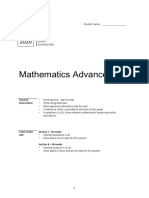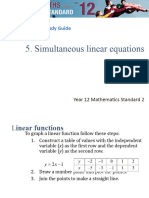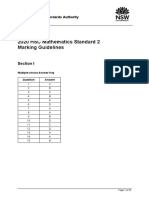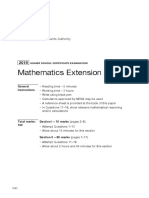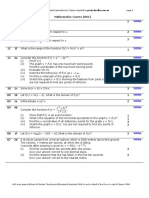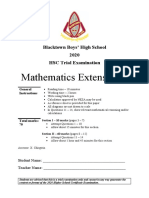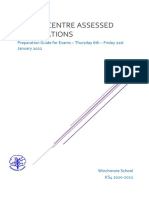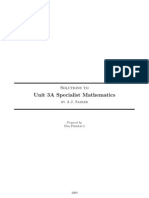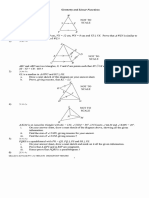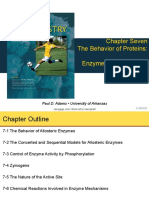HSC
Exam
Questions
(Linear
Functions)
1995
HSC
Q2
The
line
cuts
the
axis
at
(4, 0)
and
the
axis
at
(0, 3)
as
shown.
is
a
point
on
the
line
,
and
is
the
point
(0, 8).
Copy
the
diagram
into
your
Writing
Booklet.
(a)
Find
the
equation
of
the
line
.
(b)
Show
that
the
point
(16, 15)
lies
on
the
line
.
(c)
By
considering
the
lengths
of
and
,
show
that
is
isosceles.
(d)
Calculate
the
gradient
of
the
line
.
(e)
is
the
midpoint
of
the
interval
.
Find
the
coordinates
of
the
point
.
(f)
Show
that
is
a
right
angle.
(g)
Find
the
equation
of
the
circle
that
passes
through
the
points
,
and
.
�1996
HSC
Q2
The
line
is
shown
in
the
diagram.
It
has
equation
+ 2 + 9 = 0
and
cuts
the
axis
at
.
!
The
line
has
equation
= + 6,
and
is
not
shown
on
the
diagram.
!
Copy
or
trace
the
diagram
into
your
Writing
Booklet.
(a)
Find
the
coordinates
of
.
(b)
Explain
why
is
parallel
to
.
(c)
Draw
the
graph
of
on
your
diagram,
indicating
where
it
cuts
the
axes.
(d)
Shade
the
region
+ 2 + 9 0
on
your
diagram.
(e)
Write
down
a
pair
of
inequalities
which
define
the
region
between
and
.
(f)
Show
that
(8, 2)
lies
on
.
(g)
Find
the
perpendicular
distance
from
to
.
(h)
(4, 6)
lies
on
.
Show
that
is
the
point
on
which
is
closest
to
.
1997
HSC
Q3(b)
Let
and
be
the
points
(0, 1)
and
(2, 3)
respecrtively.
(i)
Find
the
coordinates
of
the
midpoint
of
.
(ii)
Find
the
slope
of
the
line
.
(iii)
Find
the
equation
of
the
perpendicular
bisector
of
.
(iv)
The
point
lies
on
the
line
= 2 9
and
is
equidistant
from
and
.
Find
the
coordinates
of
.
�1998
HSC
Q3
The
diagram
shows
points
1, 0 , (4, 1)
and
(1, 6)
in
the
Cartesian
plane.
Angle
is
.
Copy
or
trace
this
diagram
into
your
Writing
Booklet.
(a)
Show
that
and
lie
on
the
line
3 + = 3.
(b)
Show
that
the
gradient
of
is
.
(c)
Show
that
the
length
of
is
10
units.
(d)
Show
that
and
are
perpendicular.
(e)
Find
tan .
(f)
Find
the
equation
of
the
circle
with
centre
that
passes
through
.
(g)
The
point
is
not
shown
on
the
diagram.
The
point
lies
on
the
line
3 + = 3
!
!
between
and
,
and
= .
Find
the
coordinates
of
.
(h)
On
your
diagram,
shade
the
region
satisfying
the
inequality
3 + 3.
1999
HSC
Q1(a)
The
points
and
have
coordinates
(3, 4)
and
(7, 2)
respectively.
Find
the
coordinates
of
the
midpoint
of
.
�1999
HSC
Q2(b)
The
diagram
shows
the
points
(2, 0),
(3, 5)
and
the
point
which
lies
on
the
axis.
The
point
also
lies
on
the
axis
such
that
is
perpendicular
to
.
(i)
Show
that
the
gradient
of
is
1.
(ii)
Find
the
equation
of
the
line
.
(iii)
What
is
the
size
of
?
(iv)
The
length
of
is
13
units.
Find
the
length
of
.
(v)
Calculate
the
area
of
.
(vi)
Calculate
the
size
of
,
to
the
nearest
degree.
�2000
HSC
Q2
The
diagram
shows
the
points
(0, 2)
and
4, 0 .
The
point
is
the
midpoint
of
.
The
line
is
perpendicular
to
and
meets
the
axis
at
and
the
axis
at
.
(i)
Show
that
the
gradient
of
is
.
(ii)
Find
the
coordinates
of
.
(iii)
Find
the
equation
of
the
line
.
(iv)
Show
that
has
coordinates
(0, 3).
(v)
Find
the
distance
.
(vi)
Find
the
equation
of
the
circle
with
centre
and
radius
.
(vii)
Hence
show
that
the
circle
in
part
(f)
passes
through
the
point
.
(viii)
The
point
lies
in
the
first
quadrant,
and
is
a
rhombus.
Find
the
coordinates
of
.
�2001
HSC
Q2(b)
The
diagram
shows
the
points
2, 5 , (4, 3)
and
(0, 0).
The
point
is
the
fourth
vertex
of
the
parallelogram
.
(i)
Show
that
the
equation
of
is
+ 3 13 = 0.
(ii)
Show
that
the
length
of
is
2 10.
(iii)
Calculate
the
perpendicular
distance
from
to
the
line
.
(iv)
Calculate
the
area
of
parallelogram
.
(v)
Find
the
perpendicular
distance
from
to
the
line
.
�2002
HSC
Q3(c)
The
diagram
shows
two
points
(2, 2)
and
(1, 5)
on
the
number
plane.
Copy
the
diagram
into
your
writing
booklet.
(i)
Find
the
coordinates
of
,
the
midpoint
of
.
(ii)
Show
that
the
equation
of
the
perpendicular
bisector
of
is
3 + 9 = 0.
(iii)
Find
the
coordinates
of
the
point
that
lies
on
the
axis
and
is
equidistant
from
and
.
(iv)
The
point
lies
on
the
intersection
of
the
line
= 5
and
the
perpendicular
bisector
3 + 9 = 0.
Find
the
coordinates
of
,
and
mark
the
position
of
on
your
diagram
in
your
writing
booklet.
(v)
Find
the
area
of
triangle
.
�2003
HSC
Q2(b)
In
the
diagram,
is
a
trapezium
with
.
The
coordinates
of
,
and
are
(0, 0),
(1, 1)
and
(4, 6)
respectively.
(i)
Calculate
the
length
of
.
(ii)
Write
down
the
gradient
of
the
line
.
(iii)
What
is
the
size
of
?
(iv)
Find
the
equation
of
the
line
,
and
hence
find
the
coordinates
of
.
(v)
Show
that
the
perpendicular
distance
from
to
the
line
is
5 2.
(vi)
Hence,
or
otherwise,
calculate
the
area
of
the
trapezium
.
2004
HSC
Q2(a)
The
diagram
shows
the
points
(1, 3)
and
(2, 0).
The
line
is
drawn
perpendicular
to
the
-axis
through
the
point
.
(i)
Calculate
the
length
of
the
interval
.
(ii)
Find
the
gradient
of
the
line
.
(iii)
What
is
the
size
of
the
acute
angle
between
the
line
and
the
line
?
(iv)
Show
that
the
equation
of
the
line
is
+ 2 = 0.
(v)
Copy
the
diagram
into
your
writing
booklet
and
shade
the
region
defined
by
+ 2
0.
(vi)
Write
down
the
equation
of
the
line
.
(vii)
The
point
is
on
the
line
such
that
is
perpendicular
to
.
Find
the
coordinates
of
.
�2006
HSC
Q3(a)
In
the
diagram,
,
and
are
the
points
(1, 4),
(5, 4)
and
(3, 1)
respectively.
The
line
meets
the
-axis
at
.
(i)
Show
that
the
equation
of
the
line
is
2 + 6 = 0.
(ii)
Find
the
coordinates
of
the
point
.
(iii)
Find
the
perpendicular
distance
of
the
point
from
the
line
.
(iv)
Hence,
or
otherwise,
find
the
area
of
the
triangle
.
2007
HSC
Q1(f)
Find
the
equation
of
the
line
that
passes
through
the
point
(1, 3)
and
is
perpendicular
to
2 + + 4 = 0.
�2007
HSC
Q3(a)
In
the
diagram,
,
and
are
the
points
(10, 5),
(12, 16)
and
(2, 11)
respectively.
Copy
or
trace
this
diagram
into
your
writing
booklet.
(i)
Find
the
distance
.
(ii)
Find
the
midpoint
of
.
(iii)
Show
that
.
(iv)
Find
the
midpoint
of
and
hence
explain
why
is
a
rhombus.
(v)
Hence,
or
otherwise,
find
the
area
of
.
2008
HSC
Q2(b)
Let
be
the
midpoint
of
(1, 4)
and
(5, 8).
!
Find
the
equation
of
the
line
through
with
gradient
.
!
�2008
HSC
Q3(a)
In
the
diagram,
is
a
quadrilateral.
The
equation
of
the
line
is
2 1 = 0.
(i)
Show
that
is
a
trapezium
by
showing
that
is
parallel
to
.
(ii)
The
line
is
parallel
to
the
-axis.
Find
the
coordinates
of
.
(iii)
Find
the
length
of
.
(iv)
Show
that
the
perpendicular
distance
from
to
is
.
(v)
Hence,
or
otherwise,
find
the
area
of
the
trapezium
.
�2009
HSC
Q3(b)
The
circle
in
the
diagram
has
centre
.
The
line
is
tangent
to
the
circle
at
.
(i)
Find
the
equation
of
in
the
form
+ + = 0.
(ii)
Find
the
distance
.
(iii)
Find
the
equation
of
the
circle.
2009
HSC
Q5(a)
In
the
diagram,
the
points
and
lie
on
the
-axis
and
the
point
lies
on
the
-axis.
The
line
has
equation
= 3 3.
The
line
is
perpendicular
to
.
(i)
Find
the
equation
of
the
line
.
(ii)
Find
the
area
of
the
triangle
.
�2010
HSC
Q3(a)
In
the
diagram
,
and
are
the
points
(2, 4),
(12, 6)
and
(6, 8)
respectively.
The
point
(2, 2)
is
the
midpoint
of
.
The
point
is
the
midpoint
of
.
(i)
Find
the
coordinates
of
.
(ii)
Find
the
gradient
of
.
(iii)
Prove
that
is
similar
to
.
(iv)
Find
the
equation
of
.
(v)
Find
the
exact
length
of
.
(vi)
Given
that
the
area
of
is
44
square
units,
find
the
perpendicular
distance
from
to
.
�2011
HSC
Q3(c)
The
diagram
shows
a
line
! ,
with
equation
3 + 4 12 = 0,
which
intersects
the
-axis
at
.
A
second
line
! ,
with
equation
4 3 = 0,
passes
through
the
origin
and
intersects
!
at
.
(i)
Show
that
the
coordinates
of
are
(0, 3).
(ii)
Show
that
!
is
perpendicular
to
! .
(iii)
Show
that
the
perpendicular
distance
from
to
!
is
.
!"
(iv)
Using
Pythagoras
theorem,
or
otherwise,
find
the
length
of
the
interval
.
(v)
Hence,
or
otherwise,
find
the
area
of
.
2012
HSC
Q5
What
is
the
perpendicular
distance
of
the
point
(2, 1)
from
the
line
= 3 + 1?
(A)
6
10
(B)
(C)
5
8
10
(D)
8
5
�2012
HSC
Q13(a)
The
diagram
shows
a
triangle
.
The
line
2 + = 8
meets
the
and
axes
at
the
points
and
respectively.
The
point
has
coordinates
(7, 4).
(i)
Calculate
the
distance
.
(ii)
It
is
known
that
= 5
and
= 65.
(Do
NOT
prove
this.)
Calculate
the
size
of
to
the
nearest
degree.
(iii)
The
diagram
shows
the
line
.
What
is
the
slope
of
the
line
?
(A)
(B)
3
1
3
2013
HSC
Q2
(D)
The
point
lies
on
such
that
is
perpendicular
to
.
Find
the
coordinates
of
.
(C)
1
3
�2013
HSC
Q12(b)
The
points
(2, 1),
(2, 24),
(22,42)
and
(22, 17)
form
a
parallelogram
as
shown.
The
point
(18, 39)
lies
on
.
The
point
is
the
midpoint
of
.
(i)
Show
that
the
equation
of
the
line
through
and
is
3 4 + 2 = 0.
(ii)
Show
that
the
perpendicular
distance
from
to
the
line
through
and
is
20
units.
1
(iii)
Find
the
length
of
.
(iv)
Find
the
area
of
the
trapezium
.
2014
HSC
Q5
Which
equation
represents
the
line
perpendicular
to
2 3 = 8,
passing
through
the
point
(2, 0)?
(A)
3 + 2 = 4
(B)
3 + 2 = 6
(C)
3 2 = 4
(D)
3 2 = 6
�2014
HSC
Q12(b)
The
points
(0, 4),
(3, 0)
and
(6, 1)
form
a
triangle,
as
shown
in
the
diagram.
(i)
Show
that
the
equation
of
is
+ 2 8 = 0.
(ii)
Find
the
perpendicular
distance
from
to
.
(iii)
Hence,
or
otherwise,
find
the
area
of
.
